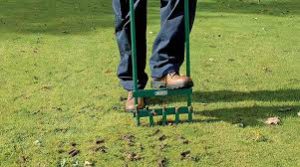When and How Do You Aerate Your Lawn?
Just like you, your lawn and your soil need to breathe. But sometimes, a little assistance is required on your part. How is that done exactly? And when is this done?
The Why, the When, and the How
Dealing with lawn-thatch and compacted soil is something that lawn aeration entails. Lawn thatch is the layer of organic matter that accumulates around the base of the grass plants. It is a combination of living and dead plant matter. The more and more build-up there is, the more detrimental it can be to the health of your lawn.
The Why
The basic idea behind lawn aeration is that, like you, your lawn and the soil under it need to breathe. But how do you accomplish this?
Aeration involves perforating the soil with small holes to allow air, water, and nutrients to penetrate the grassroots. This helps the roots grow deeply and produce a stronger, more vigorous lawn.
The main reason for aerating is to alleviate soil compaction. Compacted soils have too many solid particles in a certain volume or space, preventing proper circulation of air, water, and nutrients within the soil. Excess lawn thatch or heavy organic debris buried under the grass surface can also starve the roots from these essential elements.
Aeration creates holes down into the soil to alleviate compaction so air, water, and nutrients can reach grassroots. Deprived of their basic needs by compacted soil, lawn grasses struggle in stressful situations, such as heat and low rainfall, and lose their healthy, rich color.
Deprived of their basic needs by compacted soil, lawn grasses struggle in stressful situations, such as heat and low rainfall, and lose their healthy, rich color. Grasses gradually thin and eventually die out completely, for lack of the oxygen, water, and nutrients available just inches away. Even a single aeration session can open the avenue for these essentials to reach their mark and put your lawn back on an upward trend.
The How
Core aeration is a subset of lawn aeration, which uses a machine (lawn aerator) with hollow tines to mechanically remove plugs or cores of soil and thatch from a lawn. As a result, it reduces soil compaction, thus creating a channel through which oxygen, water, and nutrients can flow.
Through the process, lawn aeration breaks up compacted soil, which, in turn, allows water and fertilizer to permeate deeply into the root area. Grassy areas that frequent heavy foot traffic needs lawn aeration more than areas that do not. That is because constant foot-stepping compacts the soil underneath more.
aeration breaks up compacted soil, which, in turn, allows water and fertilizer to permeate deeply into the root area. Grassy areas that frequent heavy foot traffic needs lawn aeration more than areas that do not. That is because constant foot-stepping compacts the soil underneath more.
The When
It may not seem your lawn could get compacted, but it happens easier than you may think. Vehicles or small equipment is driven on lawns are more obvious offenders, but even outdoor entertaining or yard play by kids and pets can leave all or part of your lawn compacted. If you live where heavy clay soil is the norm, annual aeration is probably needed to keep your lawn from becoming thin and weak.
Dethatching and aerating are two different tasks, but they often go hand in hand. Thatch is the layer of decomposing organic matter that forms right at the lawn surface, between soil and grass. When thatch gets more than 1/2 inch thick, it works like compaction to prevent the flow of air, water, and nutrients grasses need. Aggressive spreading grasses, such as Kentucky bluegrass in northern lawns and Bermudagrass down south, form more thatch than many other grass types. Aeration helps penetrate and reduce thatch buildup or prep it for removal through dethatching.
in hand. Thatch is the layer of decomposing organic matter that forms right at the lawn surface, between soil and grass. When thatch gets more than 1/2 inch thick, it works like compaction to prevent the flow of air, water, and nutrients grasses need. Aggressive spreading grasses, such as Kentucky bluegrass in northern lawns and Bermudagrass down south, form more thatch than many other grass types. Aeration helps penetrate and reduce thatch buildup or prep it for removal through dethatching.

